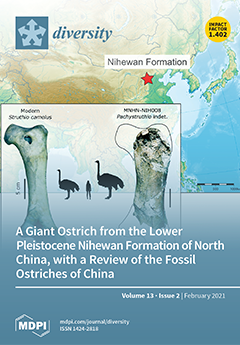We investigated population parameters using the capture-mark-recapture method (
Ituglanis passensis and
I. bambui) and visual censuses (
I. epikasrticus and
I. ramiroi). The four species are regionally threatened (Brazilian Red List) and occur in caves of Terra Ronca State Park,
[...] Read more.
We investigated population parameters using the capture-mark-recapture method (
Ituglanis passensis and
I. bambui) and visual censuses (
I. epikasrticus and
I. ramiroi). The four species are regionally threatened (Brazilian Red List) and occur in caves of Terra Ronca State Park, São Domingos region, Central Brazil. We conducted seven fieldtrips across three years of dry seasons. For the capture-mark-recapture method, a 400 m long stream inside Passa Três cave, where
I. passensis occurs and a 300 m long reach of an upper tributary where
I. bambui occurs inside Angélica cave were divided into 20 and 17 study sections, respectively. Catfishes were hand-netted, measured (standard length), weighed, marked by subcutaneous injection of biocompatible pigments, and released. The four species show medium-to-low mean population densities (0.03 ind/m
2 0.7 ind/m
2). Capture-mark-recapture data pointed to a relatively small population size for
I. passensis, restricted to a 1600 m long stream inside Passa Três cave (N = 719) and for
I. bambui (N = 246; 300 m of epikarstic drainage).
Ituglanis passensis and
I. bambui move along relatively small areas with a restricted home range. We observed recruitment patterns and a trend of decrease in condition factor during the dry seasons for
I. bambui but not for
I. passensis, suggesting that epikarstic waters are probably more limiting concerning food input.
Ituglanis passensis and
I. bambui showed low growth and consequently high longevity, corroborated by captivity data (20 years). We suggest urgent actions and long-term monitoring projects to effectively protect this unique and endemic ichthyofauna.
Full article





